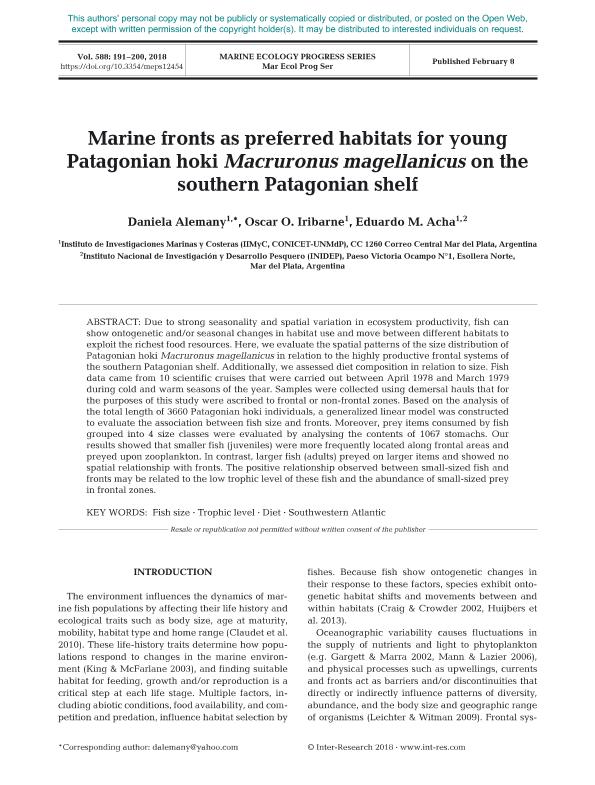Artículo
Marine fronts as preferred habitats for young Patagonian hoki Macruronus magellanicus on the southern Patagonian shelf
Fecha de publicación:
02/2018
Editorial:
Inter-Research
Revista:
Marine Ecology Progress Series
ISSN:
0171-8630
Idioma:
Inglés
Tipo de recurso:
Artículo publicado
Clasificación temática:
Resumen
Due to strong seasonality and spatial variation in ecosystem productivity, fish can show ontogenetic and/or seasonal changes in habitat use and move between different habitats to exploit the richest food resources. Here, we evaluate the spatial patterns of the size distribution of Patagonian hoki Macruronus magellanicus in relation to the highly productive frontal systems of the southern Patagonian shelf. Additionally, we assessed diet composition in relation to size. Fish data came from 10 scientific cruises that were carried out between April 1978 and March 1979 during cold and warm seasons of the year. Samples were collected using demersal hauls that for the purposes of this study were ascribed to frontal or non-frontal zones. Based on the analysis of the total length of 3660 Patagonian hoki individuals, a generalized linear model was constructed to evaluate the association between fish size and fronts. Moreover, prey items consumed by fish grouped into 4 size classes were evaluated by analysing the contents of 1067 stomachs. Our results showed that smaller fish (juveniles) were more frequently located along frontal areas and preyed upon zooplankton. In contrast, larger fish (adults) preyed on larger items and showed no spatial relationship with fronts. The positive relationship observed between small-sized fish and fronts may be related to the low trophic level of these fish and the abundance of small-sized prey in frontal zones.
Palabras clave:
DIET
,
FISH SIZE
,
SOUTHWESTERN ATLANTIC
,
TROPHIC LEVEL
Archivos asociados
Licencia
Identificadores
Colecciones
Articulos(CCT - MAR DEL PLATA)
Articulos de CTRO.CIENTIFICO TECNOL.CONICET - MAR DEL PLATA
Articulos de CTRO.CIENTIFICO TECNOL.CONICET - MAR DEL PLATA
Citación
Alemany, Daniela; Iribarne, Oscar Osvaldo; Acha, Eduardo Marcelo; Marine fronts as preferred habitats for young Patagonian hoki Macruronus magellanicus on the southern Patagonian shelf; Inter-Research; Marine Ecology Progress Series; 588; 2-2018; 191-200
Compartir
Altmétricas




